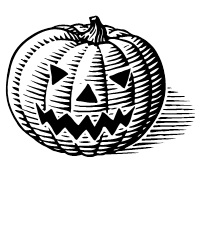 Pumpkin Carving Tips - October 23, 2013 Jeff Schalau, Agent, Agriculture & Natural Resources University of Arizona Cooperative Extension, Yavapai County Pumpkin carving has become elevated to a high art. Cutting a few triangles and a toothy smile is passť. Iím sure most readers have seen these artfully carved pumpkins Ė well, itís time to get carving. Below, Iíll discuss tools, technique, and how to make a tasty, healthy snack from the pumpkin seeds. You can purchase pumpkin carving toolkits, but chances are you have many of the tools already on hand. These include: a boning knife-good for cutting the top and larger pieces; a small paring knife or hobby knife for detail work; a mini hand held saw-good (this can be fashioned from an old coping saw blade with one end cut off and a duct tape handle); a poker tool-such as an ice pick, nail or awl; an ice cream scoop; some patterns download on computer or design your own; masking tape for attaching pattern to pumpkin; crayon or washable pen; and candles and holders. Some carvers use Dremel tools (high speed rotary cutters) for detailed work. Traditional pumpkin carvers cut the top out (including the stem) by making and angled cut so the top piece wonít fall inside the pumpkin. You may choose to cut into the top or the bottom, or for a different look, turn the pumpkin on its side. Next, open and remove the seeds and inner membranes. Set the seeds aside for roasting. For bottom cutting, cut a small hole in the bottom, discard the cut portion, and when finished just set your pumpkin right over the candle. Once you have cut into your pumpkin, remove the insides and scrape away at the pumpkin until the walls are no more than one-inch thick. Some designs may require scraping away even more. Simply designs can be done freehand. Draw your design by using a crayon or washable pen. Fancier designs usually are created from a pattern. The pattern should be towards the top of the pumpkin, not in the center. The light source should be below the pattern to allow the light to project upward. Attach your pattern with masking tape. Use a nail, ice pick, or other sharp pointed object to transfer the pattern onto the face of the pumpkin. Press the tip through the design lines on the paper about 1/8 inch apart. The tip should be pushed in far enough to go through the paper and the outer skin of the pumpkin. It is not necessary at this time to go all the way through the pumpkin. These small holes will serve as a guide for sawing. Remove the pattern and inspect the pumpkin to make sure that all lines have been transferred clearly. You can rub some flour or baking soda over the lines to help them stand out. Remember, don't use the saw like a knife. Saw slowly and gently. Start at the center of the design and work your way outward. Each time you remove a piece of the design the pumpkin gets weaker. Leave plenty of connective tissue. Accidents can happen to anyone, so if something does fall off, just put a couple of toothpicks into the area that broke off, then carefully push it back into place. You'll want to keep your Jack-O-Lantern fresh as long as possible. When pumpkins shrivel up, it's because they have lost moisture. You can usually restore them to their original condition by soaking them in water overnight. Another technique is to coat all cut surfaces with petroleum jelly immediately after carving, including the entire inside of the pumpkin. Petroleum jelly acts as a barrier to seal in the internal moisture to help slow down the dehydration process. After Halloween, put your carved pumpkin in the compost. The final step is to add a candle. Candles placed in glass candleholders are safer and last longer. Small glass jelly jars make excellent candleholders. Plain white candles give off the most light. If the lid of your pumpkin blackens, cut a small chimney hole in the top, so heat and smoke can escape. Roasted pumpkin seeds can be made by cleaning most of the chunks and strings from the seeds, for 1 Ĺ cups of seeds, toss them in 2 tsp. butter or olive oil, salt to taste, and spread in a single layer on a cookie sheet. Bake for 45 minutes at 300 degrees F. You can spice them up by adding garlic powder, seasoning salt, cayenne, Cajun spice, or your favorite seasoning. Roasted pumpkin seeds are high in fiber, vitamins B, and phosphorus. Follow the Backyard Gardener on Twitter Ė use the link on the BYG website. If you have other gardening questions, call the Master Gardener help line in the Camp Verde office at 928-554-8999 Ext. 3 or e-mail us at cottonwoodmg@yahoo.com and be sure to include your name, address and phone number. Find past Backyard Gardener columns or provide feedback at the Backyard Gardener web site: http://cals.arizona.edu/yavapai/anr/hort/byg/. |